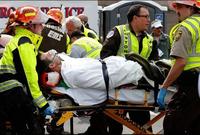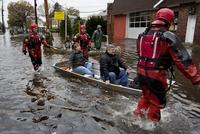-
Emergency preparednessThe Strategic Stockpile Failed; Experts Propose New Approach to Emergency Preparedness
A new analysis of the United States government’s response to COVID-19 highlights myriad problems with an approach that relied, in large part, on international supply chains and the Strategic National Stockpile (SNS). A panel of academic and military experts is instead calling for a more dynamic, flexible approach to emergency preparedness at the national level.
-
-
Perspective: Disaster techThis High-Tech Solution to Disaster Response May Be Too Good to Be True
The company called One Concern has all the characteristics of a buzzy and promising Silicon Valley start-up: young founders from Stanford, tens of millions of dollars in venture capital and a board with prominent names. Its particular niche is disaster response. And it markets a way to use artificial intelligence to address one of the most vexing issues facing emergency responders in disasters: figuring out where people need help in time to save them. That promise to bring new smarts and resources to an anachronistic field has generated excitement. But there are skeptics, and interviews and documents show the company has often exaggerated its tools’ abilities and has kept outside experts from reviewing its methodology.
-
-
Emergency alertsHawaii’s missile alert gaffe: why good human-machine design is critical
It’s an unfortunate reality that we need to prepare for national emergencies due to war or natural disasters. Civil defense organizations, set up to coordinate and respond to such emergencies, are an important part of any modern state. Such entities play a critical role in terms of triggering alerts, coordinating response across law enforcement and emergency services, disseminating information and aiding response efforts to minimize impact and restore order. Clearly, they are important systems for alerting nations to risks when disaster strikes. But such systems can go wrong. Our interaction with technology is becoming more and more complex. Early warning systems are very welcome, but the Hawaii mishap serves as an opportunity for a radical redesign, with a better understanding of their impact on the population. At a time when the world is increasingly uncertain and our dependence on technology is so high, a redesign of poor warning systems is critical.
-
-
Disaster responseS&T and New Orleans conduct flood-relief planning exercise
Flood-related disasters present significant risks to life and property across our nation. During 8-14 August 2016, 6.9 trillion gallons of rain water flooded Baton Rouge, Louisiana. In cases like the 2016 Baton Rouge flood, response agencies need assistance from surrounding communities and citizens—whether it is manpower, technology, status reports, or basic relief supplies. However, jurisdictions often have different communications systems, which can make it difficult to request help. This means that when a city is paralyzed by water, emergency responders have a difficult time maintaining situational awareness and gathering necessary resources.
-
-
Disaster responseDrawing disaster response lessons by comparing quake responses
Following the devastating 2011 Great East Japan Earthquake which hit the Tohoku region of Japan, many local and provincial governments rushed to aid the people in the area with personnel and materials, providing important relief in a time of crisis. At a recent symposium, some were comparing the response to the 2011 disaster to the response to the Great Hanshin-Awaji Earthquake of 1995 in order to draw lessons and offer guidelines in effective crisis management.
-
-
Preparation businessDisaster preparation business booms

Concerns about future manmade and natural disasters are driving the U.S. market for survival kits. Across the country, families are developing disaster plans, and some are even loading up on food and supplies to help them live through a biological attack, a catastrophic earthquake, or a pandemic flu. More and more businesses are targeting preppers, — people who actively prepare for a doomsday scenario.
-
-
PreparednessFlorida better prepared to deal with disasters than it was in 2004 -- the Year of Four Hurricanes
Much has improved for residents and emergency managers in South Florida since the state’s 2004 Hurricane season, known as the Year of Four Hurricanes. That season, Hurricane Charley released 150-mph winds, followed by Frances, Ivan, and Jeanne. Officials in South Florida are implementing new technology and improved protocols to battle the next round of extreme weather events.
-
-
PreparednessEmergency readiness of health-care providers

In 2013 the Centers for Medicare and Medicaid Services(CMS) proposed new preparedness requirements for hospitals and sixteen other types of health care providers, including home health agencies, nursing homes, hospices, transplant centers, and community mental health facilities, to mitigate natural and man-made disasters. Health-care providers say these requirements are too costly.
-
-
Crisis managementAnticipating and addressing the knock-on effects of crisis situations
Crisis situations such as an EU-wide black-out, or cross-border flooding in the Netherlands and Germany, say, can have devastating repercussions. A well-known example of such an effect is the meltdown of Fukushima’s nuclear reactors in Japan, after the power plant was hit by a tsunami, which in turn was triggered by an earthquake. Being able to anticipate such cascade effects — and put in place effective emergency measures — can help avoid catastrophe and save lives. This is why the three-year EU-funded FORTRESS (Foresight Tools for Responding to cascading effects in a crisis) project was launched in April 2014; in order to identify and better understand their cause.
-
-
Emergency managementRio builds a high tech integrated urban command center

Rio de Janeiro is one of the most densely populated cities in South America. Much of the city is vulnerable to flooding, and about three-quarters of Rio’s districts have areas at risk of landslides. High temperatures can make living situations unbearable. In addition, a high crime rate and poor infrastructure make the city difficult to govern. In preparation for the 2014 World Cup and 2016 Summer Olympics, authorities are looking to improve response times to disasters and establish a more efficient system to deal with the city’s many challenges. One of the solutions is a high tech integrated urban command center — Centro de Operações Preifetura do Rio de Janeiro (COR) – which unites Rio’s thirty departments and some private suppliers in a single monitoring room where operators can track real-time conditions of the city and coordinate a response to emergencies and disruptions.
-
-
DisastersCanada is not doing enough to prepare for, cope with natural, man-made disasters
The 2013 Alberta floods cost more than $6 billion, making it the worst weather disaster in Canada’s history. Before 1990, only three Canadian disasters exceeded $500 million, but in the past ten years alone nine disasters have exceeded that amount. Disaster management experts said that while it may be understandable that corporate and municipal budgets for disaster training and preparations have been reduced during the economic slowdown, corporate and government leaders in Canada must consider how such reductions would impact the ability of communities to build adequately resilience systems against potential natural and manmade disasters.
-
-
911 textingTexas cities adopt 911 texting

Adding to the rising number of U.S. cities that accept 911 emergency texts, North Texas public safety agencies will now institute the procedure at their response centers. 911 emergency texting not only helps the deaf, but it better caters to younger generations that do not recognize as much the divide between text and voice communications. The texting of additional media such as photos before the responders reach the site could also have a profound impact on the development of an emergency situation.
-
-
ResilienceResources on disaster preparedness, resilience

One year after Superstorm Sandy hit the eastern United States, local, state, and federal agencies as well as community groups and businesses are working to strengthen the U.S.s resilience to future disasters. A National Research Council (NRC) has issues a series of studies and reports, and has put together workshops and study groups, which should advance the national conversation on preparedness and resilience.
-
-
Infrastructure protectionMaking buildings more tsunamis-resilient
Often in disasters such as tsunamis, people escape the on-rushing wall of water by climbing to higher ground, called vertical evacuation. As people race to the third or fourth floor of a building, however, how do they know whether the building will hold up? Walls of water often carry with them cars, trucks, and 60,000-pound fully loaded cargo containers, transforming them into projectiles which slam into buildings with tremendous force. Most structural systems are designed to defy gravity, not a side kick from a shipping container. Engineers are now studying the impact of tsunami-carried debris in order to make buildings and other structures more disaster-resilient.
-
-
Emergency managementNew surveillance technologies for improved emergency management
Researchers are working to design and build resilient streaming sensor networks for emergency response such as bushfires; experts say the emergency services sector can significantly improve the availability of critical information better to manage incidents by exploiting new and emerging surveillance strategies
-
- All
- Regional
- Water
- Biometrics
- Borders/Immig
- Business
- Cybersecurity
- Detection
- Disasters
- Government
- Infrastructure
- International
- Public health
- Public Safety
- Communication interoperabillity
- Emergency services
- Emergency medical services
- Fire
- First response
- IEDs
- Law Enforcement
- Law Enforcement Technology
- Military technology
- Nonlethal weapons
- Nuclear weapons
- Personal protection equipment
- Police
- Notification /alert systems
- Situational awareness
- Weapons systems
- Sci-Tech
- Sector Reports
- Surveillance
- Transportation
Advertising & Marketing: advertise@newswirepubs.com
Editorial: editor@newswirepubs.com
General: info@newswirepubs.com
2010-2011 © News Wire Publications, LLC News Wire Publications, LLC
220 Old Country Road | Suite 200 | Mineola | New York | 11501
Permissions and Policies
Editorial: editor@newswirepubs.com
General: info@newswirepubs.com
2010-2011 © News Wire Publications, LLC News Wire Publications, LLC
220 Old Country Road | Suite 200 | Mineola | New York | 11501
Permissions and Policies
